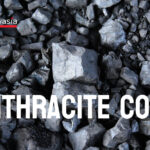Anthracite and bituminous coal are two major types of coal, each with distinct properties, uses, and geological origins.
Anthracite coal is a high-quality and clean-burning variety of coal. It is dense, compact, and contains a high carbon percentage, thereby making it a good material for steelmaking. Anthracite coal generates high heat and burns with minimal or no smoke or ash.
Dark brown to black, bituminous coal is often banded or laminated. Microscopically, three broad groups of macerals (individual organic components of coal) may be distinguished: vitrinite, liptinite, and inertinite. Due to its comparatively high heat value and low (less than 3 percent) moisture level, ease of transportation and storage, and abundance, bituminous coal finds the widest range of commercial applications among coals. It has been used for years to generate steam in electric power plants and industrial boiler plants.
Anthracite and bituminous coal are two common types of coal, differing in carbon content, energy output, and uses. Here’s a comparison:
-
Carbon Content & Energy Value
Anthracite:
Highest carbon content (86–97%).
Highest energy output (~25–30 MJ/kg).
Burns cleanly with little smoke.
Bituminous:
Lower carbon content (45–86%).
Lower energy than anthracite (~24–29 MJ/kg).
More volatile matter, producing more smoke.
-
Formation & Rank
Anthracite is the highest-grade coal (metamorphic), formed under intense heat and pressure.
Bituminous is mid-grade (sedimentary), softer, and more abundant.
-
Uses
Anthracite:
Preferred for home heating (clean burn).
Used in metallurgy and water filtration.
Rare (~1% of global coal reserves).
Bituminous:
A major source of electricity generation.
Used in steelmaking (coking coal).
More common (~52% of global reserves).
-
Combustion & Pollution
Anthracite burns longer, hotter, and cleaner (low sulfur).
Bituminous emits more pollutants (SO₂, particulates).
-
Availability & Cost
Anthracite is rarer and more expensive.
Bituminous is widely mined (U.S., China, India).
Comparison Table of Anthracite and Bituminous Coal.
| Feature | Anthracite Coal | Bituminous Coal |
| Carbon Content | 86–97% | 45–86% |
| Heating Value | Highest among coal types | Lower than anthracite |
| Hardness | Hard, brittle, shiny | Softer, more layered |
| Volatile Matter | Very low | Moderate to high |
| Moisture Content | Negligible | Present |
| Availability | Rare (e.g., <1% of U.S. coal mined) | Most abundant coal type |
| Main Uses | Industrial heating, the metals industry, and some domestic uses | Electricity generation, steel industry, and industrial fuel |
| Environmental Impact | Cleaner burning, lower emissions | Higher emissions, more pollution |
| Cost | Higher | Lower |
Anthracite and bituminous coal are two common types of coal, differing in carbon content, energy output, and uses.
Anthracite is the highest rank of coal, with a high energy content, clean burn, and hardness, but is scarce and used primarily for heating and metallurgy. Bituminous coal, though lower in rank, is the most common and widely used to generate electricity and for industrial purposes because of its high energy content and availability.
Want to know more about Anthracite coal? Click to know more.






